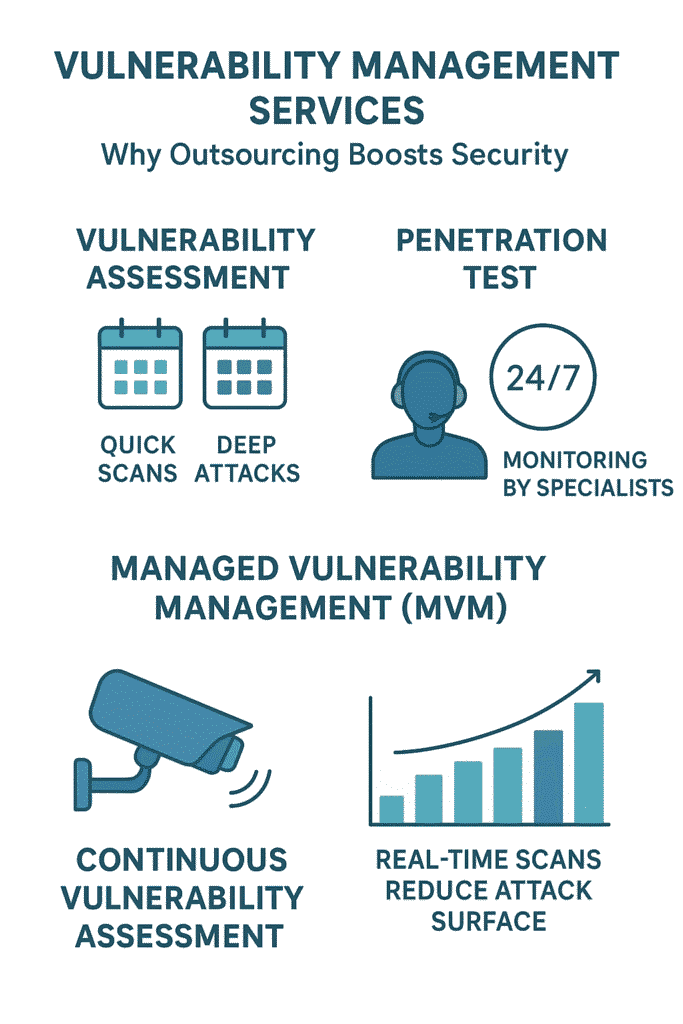Address
304 North Cardinal St.
Dorchester Center, MA 02124
Work Hours
Monday to Friday: 7AM - 7PM
Weekend: 10AM - 5PM
Address
304 North Cardinal St.
Dorchester Center, MA 02124
Work Hours
Monday to Friday: 7AM - 7PM
Weekend: 10AM - 5PM

Most security breaches start with a weakness nobody caught in time. It’s not rocket science , vulnerability management just means finding and patching holes before attackers do. Think of it like getting a yearly check up, except for computer systems that need weekly monitoring.
While some companies run their own scans, others hire specialists who do this 24/7 (and probably catch more issues). The main thing to remember: scanning for problems isn’t the same as testing if someone can break in. There’s more to this story, and any company handling sensitive data should keep reading.

Security folks mix these terms up all the time, but they’re actually pretty different beasts. Vulnerability assessments work kind of like those yearly physicals everyone’s supposed to get , they’re quick, automated checks that scan your network looking for anything that seems off.
Maybe there’s some software that hasn’t been updated since last spring, or ports left wide open that shouldn’t be. These scans cast a pretty wide net, checking everything to make sure the basics are covered.
Now pen testing, that’s something else entirely. It’s more like getting your black belt in network defense , experts come in and try their hardest to break into your systems, just like a real attacker would.
They’ll spend days (sometimes weeks) digging around, looking for creative ways to exploit any weakness they find. It’s hands-on, intense work that shows exactly how bad things could get if someone decided to target your network.
Most places run those vulnerability scans pretty often , some do it weekly, others monthly, and the really careful ones might even scan daily. Pen tests don’t happen nearly as much, usually just once or twice a year, or before rolling out major system changes.
You need both though: scans catch problems fast, while pen tests prove whether your defenses actually work under pressure.
Think of managed vulnerability management (MVM) as hiring a professional security team without actually hiring anyone.
Instead of trying to handle everything in-house, companies hand off the whole vulnerability process to specialists who do this stuff for a living , usually through what’s called an MSSP (that’s Managed Security Service Provider).
These MVM folks keep an eye on things 24/7, running constant scans and letting you know right away if something looks sketchy. They’ve got fancy tools that use threat intelligence and risk scoring systems (like CVSS or EPSS) to figure out which problems need fixing first.
Plus, they’ll handle all that mind numbing compliance paperwork for things like PCI DSS or SOC 2, which is a huge relief during audit season.
The whole point is turning mountains of technical data into something useful without burning out your own IT team. It’s perfect for companies that don’t have the people or know-how to run their own full scale vulnerability program , which, let’s face it, is most companies these days.
The real power behind letting someone else handle your vulnerability scanning comes down to this:
Basically, if you don’t want the hassle of doing all this yourself but still need solid security, outsourcing’s probably your best bet.

Credit: pexels.com (Photo by cottonbro studio)
There’s a new security problem popping up pretty much every day now. Sometimes it’s buggy software, sometimes it’s a configuration mess-up, and sometimes it’s something nobody’s ever seen before. That’s where continuous vulnerability assessment (CVA) comes in.
These services are running scans while you’re sleeping. Instead of waiting around for some yearly security check that costs a fortune, CVA keeps an eye on things 24/7. When something’s wrong, you’ll know about it right away, not three months from now.
Most providers give you these really clean-looking dashboards (that don’t require a PhD to understand), where you can see what’s wrong and what needs fixing first.
It’s like having a security camera running all the time, except it’s watching your network instead of your parking lot.
According to SecurityScorecard, there were 29,000 known vulnerabilities logged in 2023, and by mid-2024, nearly 27,500 more had already surfaced. Moreover, the Coalition 2024 Cyber Threat Index projects CVEs will hit 34,888, a 25 % increase year over year (1)
Nobody really wants to admit it, but finding security holes isn’t the hard part anymore , it’s fixing them before something bad happens. Most MSSP service offerings from these providers stick to this basic pattern for dealing with vulnerabilities:
The real trick? Focusing on the stuff that matters. Fix the holes in systems that keep the lights on first, especially if there’s word that attackers are already taking advantage of them. Sure, automation helps speed things up, but you’ve got to be smart about it.

Credit: pexels.com (Photo by Tima Miroshnichenko)
Let’s face it, some security holes are just paper cuts, while others are gaping wounds. Here’s what actually matters when deciding what to fix first:
Nobody likes to hear it, but you’ve got to test patches before rolling them out , breaking production systems while trying to secure them isn’t going to win any friends. Getting IT teams, security folks, and the application developers to work together isn’t always pretty, but it’s necessary.
That’s what makes the difference between just doing security work and actually making systems safer.
Nobody really likes dealing with compliance scans, but they’re pretty much everywhere these days. The big credit card companies want their quarterly PCI DSS scans (and they won’t take no for an answer).
Then there’s SOC 2 breathing down everyone’s neck about security checks, and don’t even get started with HIPAA’s rules about keeping patient data safe.
Here’s the thing about compliance scans , they’re not just looking for the usual security holes. They’re poking around to make sure you’ve got all your ducks in a row with things like proper encryption (256,bit AES, usually).
Audit trails that actually work, and making sure only the right people can get into systems. It’s kind of like having a really picky inspector come through your house.
The paperwork’s probably the worst part. You’ve got to show exactly when you ran scans (down to the minute sometimes), how long it took to fix problems, and keep enough detailed reports to fill a small library.
Some companies are smart and just hire outside help to handle all this stuff , saving a lot of late nights before audits.
Picking the right tool’s kind of like choosing a car, you’ve got to think about what you actually need. Here’s what matters:
At the end of the day, you’ve got to pick something that matches where your company’s at with security. No point getting the Ferrari of security tools if you’re still figuring out how to change the oil, right?
Picture a fortress , yeah, that’s basically your network. And just like any fortress, it’s got weak spots that need constant attention. There’s no magic solution, but there are some pretty straightforward ways to keep the bad guys out (or at least make their job a lot harder).
A smaller attack surface means fewer headaches. That’s just basic math.
Managing vulnerabilities isn’t a one,and,done thing , it’s more like mowing the lawn, except the grass is trying to steal your data. Here’s how MSSPs (Managed Security Service Providers) handle it:
The whole thing just keeps going round and round, like a really paranoid merry,go,round. Most MSSPs use fancy tools to automate what they can, but there’s still plenty of human expertise involved (machines aren’t great at context, after all).
Someone’s probably scanning your network right now. Not in a creepy way, more like how a security guard checks door locks. That’s what network vulnerability scanning does, except it’s checking thousands of digital doors in minutes.
These scans hunt down four main issues:
There’s two ways to run these scans. The first is like checking a house from the outside , you see what any random person might spot. But when you’ve got the keys (that’s what we call credentialed scans), you can look in all the closets and under the beds for the really sneaky problems.
Running these scans isn’t just smart, it’s needed for most security policies these days. Think of it as a regular checkup, except instead of blood pressure, we’re checking if someone could break in through port 80. Fix what the scan finds, and the network stays healthier.
The whole thing’s pretty straightforward, scan, find problems, fix them, repeat. Like brushing your teeth, except for computers. And just as necessary.
Understanding how vulnerability management services work can transform your security posture. Whether you choose in-house programs or outsource to MSSPs, the goal remains the same: detect vulnerabilities early, prioritize fixes wisely, and reduce your attack surface continuously.
Outsourcing vulnerability scanning and management helps organizations stay on top of threats without overwhelming internal teams. Continuous vulnerability assessment services keep the security baseline fresh, while expert remediation guidance ensures patches get applied where they matter most.
For those seeking a practical, scalable approach to vulnerability management, working with managed services and adopting best practices in patch prioritization and compliance scanning is a smart move.
If your organization struggles with vulnerability overload or patching delays, consider exploring vulnerability management as a service (VMaaS). It might just be the security boost your team needs.
That’s where our team comes in. We offer expert consulting tailored for MSSPs to help streamline operations, reduce tool sprawl, and boost service quality.
From vendor-neutral product selection and auditing to stack optimization and decision support resources, we guide you in choosing the right tools, improving integration, and enhancing visibility.
With over 15 years of experience and 48K+ projects completed, our services include needs analysis, vendor shortlisting, PoC support, and clear, actionable recommendations, so you can build a tech stack that aligns with your business goals and operational maturity.
See how we can help you streamline and strengthen your security operations
Vulnerability management services help organizations find and fix security gaps across networks, apps, and devices. When delivered as vulnerability management as a service, or VMaaS, these tools and workflows are hosted in the cloud and managed externally.
Vulnerability scanning checks systems for weaknesses, while penetration testing goes further by safely exploiting them to show real risks. Continuous vulnerability assessment builds on both by running checks more often, giving near real-time insight.
Not all issues are equal. Vulnerability prioritization helps teams decide which fixes to apply first using risk-based vulnerability management, CVSS scoring, and vulnerability risk scoring. This approach works closely with patch management, vulnerability remediation services, and software vulnerability patching.
Vulnerability monitoring tracks threats over time, while vulnerability reporting turns technical findings into clear updates for decision-makers. Many organizations use a vulnerability dashboard, vulnerability management tools, and vulnerability detection tools to measure progress.